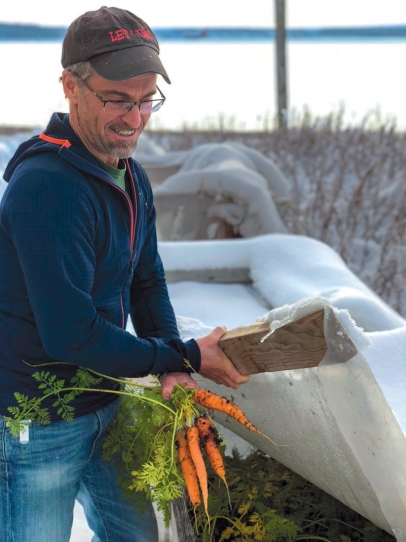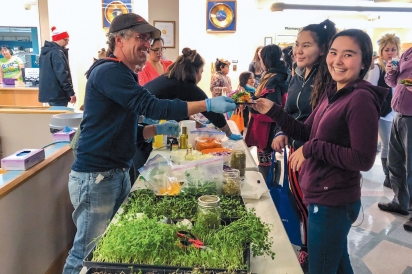Bjorn’s Den: Arctic Food Dude
A Conversation with Seth Kantner
One of Seth Kantner’s earliest memories is of waking up alone in his family’s small sod igloo in Northwest Alaska. It was spring, when caribou move north to their calving grounds on the Arctic coastal plain. He went outside searching for his parents and was relieved to find them nearby, skinning a caribou. Kantner’s mom and dad had moved to the wild country years before and built their semisubterranean home in a bluff above the Kobuk River. They learned from the land, the animals, and the Iñupiat people, who have lived there since time immemorial. Nearby was a migration route, which, at least historically, a significant portion of the Western Arctic caribou herd traveled through in the spring and fall.
“My memories are soaked in ‘caribouness,’” Kantner said with a laugh.
Despite the occasional abundance of life, it was still hungry country. Life was governed by the seasons and sustained by the annual availability of migrating animals. None was more important than caribou. Their meat, hides, and presence were invaluable, and remain so in some of the same ways now for Kantner and many people of the north.
These days, Kantner works as a commercial fisherman, gardening teacher, wilderness guide, photographer, and writer. If you haven’t read his books, you should. His writing, among other things, thoughtfully explores the importance of food from the land and how food is our strongest connection to place. Caribou remain central to his life and work. His most recent book, A Thousand Trails Home: Living with Caribou, tells the history of caribou in Alaska’s Arctic and his and other local peoples’ relationship with the animal. The book also addresses the uncertainty that caribou, the land, and the people of the north face.
Kantner’s love of food goes beyond what he hunts, fishes, and gathers/ gardens. His first attempt at growing food was when he and his older brother were six and seven, respectively. They readied the earth and each planted a piece of potato. The brothers took care of their two potato plants and when fall came around they were rewarded with 10 pounds of potatoes they added to their larder of meat, berries, and fish. In the following years, the family became avid gardeners. When Kantner was nine years old his dad built a wooden fishing boat, and each summer, after the family planted their garden, they’d head down the Kobuk River to the coast, to camp and fish for six or seven weeks.
“When we boated home in the fall the first thing we did was unload the dogs, then run to check all our gardens to see what grew and what didn’t. It probably sounds weird, but for us it was huge excitement,” Kantner said.
Around the same time that his family took up gardening, the Garden Project was created to encourage and assist gardening in villages of Northwest Alaska. Seth started working for the Garden Project 27 years ago. He claims the seasonal part-time work is the closest he’s ever come to having a real job—something that he’s purposely avoided so he can spend more time hunting and fishing, roaming the land with his camera, and being home along the river. Due to climate change, the gardening season is a month or more longer than it was half a century ago when the Kantner brothers first planted potatoes. Turnips are a local favorite, and potatoes, carrots, cabbage, lettuce, and other leafy vegetables also grow well. According to Kantner, trying to teach and encourage gardening is an uphill battle at times, and it’s not always easy to explain the purpose of it with the flood of store-bought food into the far north, increased access to Costco supplies, and Amazon orders available at villagers’ fingertips.
“The modern world is good at confusing what we value. You can get so spoiled with plenty,” Kantner said.
Which brings him back to caribou. Getting a caribou used to be something that he took relatively for granted. Now, with the Western Arctic Caribou Herd shrinking due to climate change, hunting pressure, and predation, finding a fat bull caribou in the fall can be hard.
“It’s frightening. At what point do we suddenly realize the true value of caribou? When there are two left? Locals would miss caribou meat the most of any meats. I try to emphasize how much we’d miss caribou if they were gone,” Kantner said.
The land also offers other delicious edibles. Kantner loves white-fronted geese, black bears that have feasted on blueberries, and musk ox. But, he points out, caribou are a standard table fare for him and many folks in Northwest Alaska.
“I’m a huge fan of a Dutch oven pot roast. I’ll take a shoulder or knee, roast and sear both sides, then cook it slowly for several hours. Caribou meat can be kind of unforgiving if it’s cooked like you could cook beef. It isn’t marbled like bear or musk ox. I often cut chunks of fat to add when I’m cooking soup or a roast and always make sure there’s a bone or bones in the pot,” Kantner said.
The Kantner’s family’s outlook on food and the land hasn’t changed much since Seth’s early memories of his dad bringing home caribou meat. His parents eventually moved to Hawaii, in large part because it’s a great place to grow food. His dad is 87 and this year, worried about food shortages, is planting more fruit trees in case other people in the future need the food. Kantner is adamant that a relationship with the land and food is something that people can and should experience.
“I wanted my caribou book to explore and explain our local connections to nature while, at the same time, to be a larger example of all peoples’ connection to the earth. Whether it’s New Jersey or Alaska,” Kantner said, “these connections are still possible, and I think important.”






